Click here for the first post in this series.
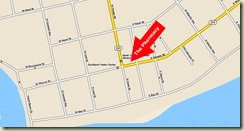 Well, in Southport, North Carolina, it’s hard for visitors to walk directly to anything. In the downtown area, anyway. Because the streets are lined with interesting shops. Antiques, art, jewelry, museums, and so on.
Well, in Southport, North Carolina, it’s hard for visitors to walk directly to anything. In the downtown area, anyway. Because the streets are lined with interesting shops. Antiques, art, jewelry, museums, and so on.
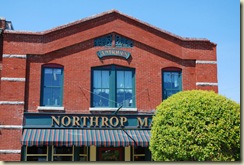 As you might imagine, we browsed through several of them on the way toward the water. Took forever! Since two of our group [no names here …] were Olympic-Class shop browsers!
As you might imagine, we browsed through several of them on the way toward the water. Took forever! Since two of our group [no names here …] were Olympic-Class shop browsers!
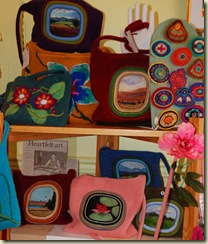 And every shop we visited featured a nice balance of quality and price. Very little of the tacky impulse-buy stuff that so often clogs the aisles of such tourist-town shops. Lots of attractive crafts and art.
And every shop we visited featured a nice balance of quality and price. Very little of the tacky impulse-buy stuff that so often clogs the aisles of such tourist-town shops. Lots of attractive crafts and art.
Here’s just one example. This photo isn’t likely to do justice to the objects. But click on it anyway for a larger view. These are the creations of local resident Kathy McVeigh. Small purses made of felt on which she recreates photographic scenes through some sort of needle work that I don’t understand. They are remarkable pieces. And inexpensive. Though not cheap. Just one example.
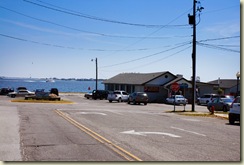 We finally made it down South Howe Street far enough to see the water. The pace picked up from there. Waterfront Park awaited our arrival.
We finally made it down South Howe Street far enough to see the water. The pace picked up from there. Waterfront Park awaited our arrival.
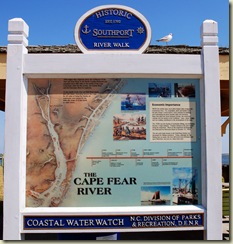 The water you see here is the mouth of the Cape Fear River. You can read all about it by clicking here. Southport has done a great job with its Waterfront Park. Lots of places to sit to look out over the water. Even sturdy two or three-person swings of the sort we used to have on our porches.
The water you see here is the mouth of the Cape Fear River. You can read all about it by clicking here. Southport has done a great job with its Waterfront Park. Lots of places to sit to look out over the water. Even sturdy two or three-person swings of the sort we used to have on our porches.
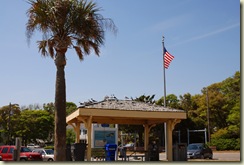 Also a nice pavilion with tables and chairs that must be appealing in the summer. And during rain showers. As you see in the photo above, the sea gulls prefer the roof. Probably a macho sea gull thing. With the one atop the flagpole winning the contest.
Also a nice pavilion with tables and chairs that must be appealing in the summer. And during rain showers. As you see in the photo above, the sea gulls prefer the roof. Probably a macho sea gull thing. With the one atop the flagpole winning the contest.
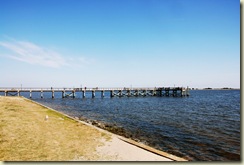 Southport also maintains a nice fishing pier that juts out a good ways into the river. Here’s a view from the middle of Waterfront Park.
Southport also maintains a nice fishing pier that juts out a good ways into the river. Here’s a view from the middle of Waterfront Park.
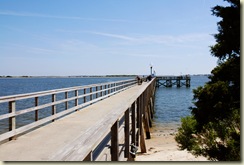 And here it is from the entrance. The Town must spend a healthy portion of their budget on their maintenance crews. Evidence of that throughout the downtown area.
And here it is from the entrance. The Town must spend a healthy portion of their budget on their maintenance crews. Evidence of that throughout the downtown area.
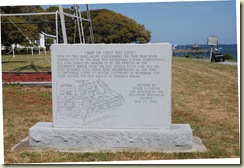 Walking up toward the edge of the downtown area from the river shore we came across this interesting stone monument. Click to have a look at the inscription. It’s a map of “Smithville’s” original 100 lots. Laid out in 1790 by Joshua Potts.
Walking up toward the edge of the downtown area from the river shore we came across this interesting stone monument. Click to have a look at the inscription. It’s a map of “Smithville’s” original 100 lots. Laid out in 1790 by Joshua Potts.
This stone monument is a fine example of the way Southport planners have recognized the importance of the town’s history. And how they have integrated knowledge of that history into their civic promotion strategy. Click here to visit the Southport Historical Society’s website. Lots of interesting material there that helps to explain the town and what’s to be seen when you visit.
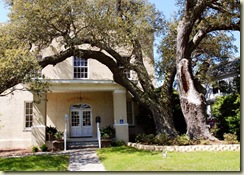 Speaking of which, here’s a shot of Southport’s town hall. Both the building itself and that remarkable live oak tree illustrate the civic promotional efforts of this remarkable town. Click here to visit the Town’s website.
Speaking of which, here’s a shot of Southport’s town hall. Both the building itself and that remarkable live oak tree illustrate the civic promotional efforts of this remarkable town. Click here to visit the Town’s website.
We went inside and spoke briefly with City Manager, Alan Thornton. He was sitting at a table by the window that looked out on that remarkable tree and lawn preparing the town budget. Talk about a challenge! I asked about the live oaks we’d seen throughout town. He said that an arborist employed by the city maintains all of them on city property.
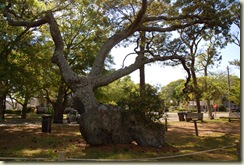 Here’s one of those trees near the Visitor’s Center. The “Indian Trail Tree.” Thought to be over 800 years old. Bent when still a sapling by American Indians to mark the trail to their fishing grounds. It’s a remarkable sight. But think of assuming responsibility for its care! Southport apparently has recognized its significance and potential, and we visitors are the beneficiaries.
Here’s one of those trees near the Visitor’s Center. The “Indian Trail Tree.” Thought to be over 800 years old. Bent when still a sapling by American Indians to mark the trail to their fishing grounds. It’s a remarkable sight. But think of assuming responsibility for its care! Southport apparently has recognized its significance and potential, and we visitors are the beneficiaries.
 By the time we reached the Indian Trail Tree and Visitor’s Center it was well after 4:00 p.m. The Center, unfortunately, had closed. So instead we visited The Christmas House you see in the photo above. Be sure to stop there before leaving. They have much more for sale than Christmas ornaments. Including delicious hand-dipped ice cream. That has to be eaten out on one of the Christmas House’s porches or patios for full effect.
By the time we reached the Indian Trail Tree and Visitor’s Center it was well after 4:00 p.m. The Center, unfortunately, had closed. So instead we visited The Christmas House you see in the photo above. Be sure to stop there before leaving. They have much more for sale than Christmas ornaments. Including delicious hand-dipped ice cream. That has to be eaten out on one of the Christmas House’s porches or patios for full effect.
Southport, North Carolina is a wonderful place to visit. But be sure to arrive early in the day, and to have made arrangements to spend at least one night. Just too much to see in a single afternoon, or even a single day.
Stay tuned. Next the Mobile Studio will be back in South Caroloina parked at Lee State Natural Area. Lots to see and do there. I’ll try to keep you posted.




Thanks for the flattery. And you encouraged me to document* the needle-felting process for those who visit Duck, Duck, Goose and see my work but leave wondering how it was done. A little less perplexing mystery, I hope! Kathy McVeigh
ReplyDelete----------------
* Felting is the age-old process whereby fibers are matted and compacted together to create a fabric. One may use various fibers but sheep wool has always been especially popular. Sheep wool yarn or unspun fleece (combed / "carded" fleece is called roving and comes in hanks) can be used to make excellent felt. The key ingredient in making felt is agitation. The agitation may be afforded by either a wet or dry process.
I felt my plain knitted bags by throwing them in with the laundry. In fewer than 7 minutes the felting process for the knitted bag itself is done. This is one example of using a wet felting process.
The embellishment of the bags - with pins, sculptural floral forms, or landscape "paintings" - is accomplished by needle-felting dry yarn, roving and/or fleece. The needle is a very thin 4" steel stiletto with tiny nicks and barbs at the tip and an L-shaped bend at the top of the shaft. (The needles are designed and used for the mechanized commercial manufacture of felt.) There is no "eye" as there would be with a traditional sewing needle. The fiber to be felted is placed on top of the substrate (a felted bag, a boiled wool jacket, a mitten, a piece of good-quality commercially-made felt, etc…) and the needle drives micro-fibers of wool into the substrate, fusing them together. In the end, what were the loose fibers are bonded together and into the substrate making it all one felted piece. The process is essentially permanent.
Many artisans who work with wool also dye the wool. I do not. I purchase wool fibers of various colors and then use a manual process to mix small amounts of several fibers to get exactly the colors I want for a particular work. I also use yarns, frequently un-twisting them to use but a single strand, or fraction of a strand, for fine details.